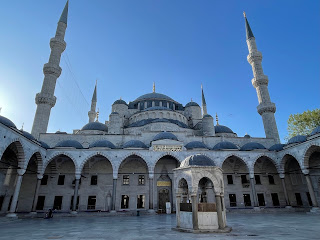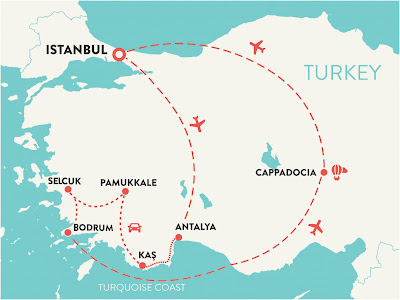Taste of Two Continents - A Food Tour Through Istanbul
Every city has a food tour. And every city we go to, we never go on them. If you know us, or follow my blog, then you know we aren't foodies! But right away when I started planning the trip, I couldn't go to any website or blog without being directed to the Taste of Two Continents food tour. The #1 tour in Istanbul, it is praised for taking you off the beaten track to sample the authentic tastes of Istanbul. Although tours from Viator are not my thing, this one has hundreds of all-perfect reviews. As an added bonus, in addition to being guided through Turkish cuisine, the tour promised to also give an overview of Turkish history and culture. Sold! I convinced myself there couldn't be a better way to introduce ourselves to Istanbul and all the food we would be eating along the trip.
The private tours are run by the husband and wife team Furcan Gokcel and Derya. Derya met us at our apartment first thing in the morning. We hit it off instantly. She got us on the tram line at our nearest station: Sultanahmet. The transportation is what I didn't want to figure out in the heat of the moment on the first day, but it couldn't be easier.
Getting off the tram over the Galata Bridge in Karaköy, we started with a traditional Turkish breakfast, better known as kahvaltı. With a line-up of tastes all its own, an elaborate and leisurely kahvalti takes at least a couple hours and consists of fresh cheeses, olives, fresh bread, jams and honey with sweet butter, an egg dish called menemen, tomatoes and cucumbers, slices of sucuk sausage, pastırma (a yummy cured beef) and of course a hot cup of chai. Not drinking coffee until after breakfast, Turks start the day with chai (tea) - and continue drinking it throughout the day, like Derya who often drinks 30-40 cups in one day!
If I am reborn I'm going to be a cat (or dog) living the best life In Istanbul.
A kahvalti /Turkish breakfast spread is huge and delicious!
Trying to pace ourselves for all the food yet to come, we didn't finish all the breakfast. And there is no taking away leftovers here because it all goes to the cats and dogs. Derya taught us our first two words of Turkish, tamam (ok, done) and haydi ("heidi" - let's go).
Pretty umbrellas hanging over a pedestrian street in Karaköy
Next up on the agenda was a small cup of Turkish coffee. Derya told us about the Turkish marriage custom that the bride serves coffee to the two sets of parents. She just needs to ask how much sugar they want. (There is no milk in Turkish coffee.). For the groom's coffee, instead of asking him, she adds salt and pepper in any quantity she wants, and he must drink it to prove his devotion!
Turkish coffee is strong and thick. The coffee grounds, left in the coffee when served, settle to the bottom.
I was the chosen one! Bikini, the cat who hangs out here, was offered our leftover water, then hopped up onto my lap!
At this point, Greg has not yet realized … he thinks we were on a food tour today but it was actually a "Cats of Istanbul" tour. (He already stated if we wanted to see cats he could've taken us to an animal shelter back home.) The "kedi" understood the assignment and came out in force! There are as many cats as people here. For more information you can watch the a documentary, Kedi, on the cats of Istanbul. You get their attention by saying "ps ps ps". Careful though, don't underestimate the power of the calling spell unless you have enough treats for a swarm!
Next we stopped at Uretim ve Satis, a shop that produces three tons of baklava each day. That is no small feat! It takes all day when Derya's mom makes her recipe - with 100 layers of phyllo.
Dating back to the ancient Assyrian Empire including Turkey, baklava is a rich and sweet pastry made with layers of phyllo dough filled with chopped nuts and held together with syrup or honey - and comes in all varieties
Our six pieces of baklava cost $10-12. For $40 you can get a kilo - about a small box's worth. (Devya told us that right now Turkey is one of the most expensive countries in Europe.)
We stopped for a balik sandwich that was much tastier than the one we had yesterday - I even tried a bite!
On our way to the ferry, we took a quick walk though the spice market, known locally as the Egyptian Market. It is full of individual booths with hawkers eager to sell you their wares. One of them asked Rachel, "Do you want to spend money?"
The Spice Bazaar has been the center of spice trade since 1660
At the Egyptian (spice) Market we tried authentic Turkish Delight from a place that produces it themselves.
Here we sampled everything they were selling: Turkish Delight, tea, spices, saffron, nuts, chocolate, perfume, lotion, and even menthol.
Turkish Delight is an iconic dessert or candy in Turkish cuisine
Crossing the street to get to the ferry, Derya stopped us from going in front of a stopped car with a female driver. "In Istanbul we don't trust the weather, water, or women," she explained.
To get to Istanbul's Asian side, you have to cross the Bosphorus Strait. There are only three bridges, none nearby, so pedestrians take the 20-minute ferry.
On the ferry to Istanbul's Asian side
The Bosphorus Strait has been one of the most important maritime routes since ancient times and is vital for oil and other cargo transportation. From the ferry you get a great view of Topkapi Palace, Hagia Sophia, and the Blue Mosque. We also saw a few dolphins!
We were headed to Kadıköy because it offers a more authentic insight into what living in Istanbul is really like and is best known for its vibrant food scene. Derya asked if I would eat muscles and intestine. "Not without a shot first," I joked. (Alcohol is not part of our tour.)
We took a detour so I could get some liquid courage for the foods up next on the list. At the bar, a sign read: This hönönö tastes like I'm not going to work tomorrow.
Hönönö is a secret concoction of different clear alcohols topped with soda water. The bartender puts a napkin around the rim, slams it down, and then you must drink the fizzing sensation as fast as you can before it spills everywhere. You can only get it at this bar.
Devya said this street is called Hungover Street because after everyone stays up late drinking they come here to eat. (Istanbul never sleeps.)
They serve their muscles packed with rice. After a bite of intestine sandwich, I'm going to need another hönönö.
Kadıköy is famous for its pickle shops. We sampled pickled plums, green beans, pickles, and peppers.
One of the last foods of our tour was lahmacun, a type of flatbread/wrap topped with a variety of different ingredients like minced meat (commonly lamb or beef), vegetables, pickles, herbs, onions, tomatoes, and spices.
To eat it, you roll up the lahmacun with different toppings - we had parsley with lemon.
As I realized the tour was about to come to the end, I was surprised how hungry I was! Until it occurred to me … the tour was six hours long, passing through both breakfast and lunchtime. We'd been walking many miles and I had been pacing myself by hardly eating more than a bite of each food item.
It wouldn't be a proper food tour of Istanbul without having kebab - the last stop on our tour.
Rather than say goodbye to our new friend Devya, we found ourselves booking another tour for the next day!
Within a few minutes from the start of our tour this morning, Derya asked us where tulips are from. Right off the bat I passed the test. Since April is Istanbul's tulip festival, I'd already done my homework and knew the answer: Turkey! While Holland is most famous for its tulips, they are actually native to Turkey. Tulips were brought to the Netherlands in the 16th Century via the Ottoman Empire.
Every April you can find millions of tulips around Istanbul and in its parks.
A good place to see tulips is Gülhane Park next to Topkapi Palace.
I was invited to a lot of carpet stores today. Devya said it's ok to say no thank you and then ignore them - but it feels so rude and practically impossible. I thought I'd give it a try, but while waiting at the Blue Mosque for it to re-open after prayers, I was duped. Pretending to work at the mosque, the guy started talking to us - and we were trapped in line. One thing led to another and next thing I knew he was offering us $500 for our daughter to marry his son (sight unseen). It was an entertaining conversation.
There are more than 3000 mosques in Istanbul and you can go into any or all of them! The main thing to remember is that girls must cover their hair, and everyone must cover the shoulders and knees and remove their shoes.
Our first mosque - and our last stop of this long day - is the Blue Mosque. Built between 1609 and 1616 directly across from Hagia Sophia, the Blue Mosque was commissioned to be even larger and more grand than its neighbor.
The best time to capture a picture of the Blue Mosque is right before it opens at 8:30am
While the Blue Mosque's exterior is extremely impressive, its claim to fame is the thousands (21,043) of blue Iznik tiles that adorn the interior. The Blue Mosque is officially named the Sultanahmet Mosque after the sultan who built it.
Unique among Ottoman mosques, the Blue Mosque was the only sultan mosque with six minarets instead of the usual four. This was controversial at that time since the holiest Great Mosque in Mecca also had six minarets, so Sultan Ahmet added a 7th minaret to Mecca.
The Blue Mosque is beautiful inside - but not as blue as I was expecting because not all of the Iznik tiles are blue. They hung ostrich eggs from the lights to ward off spiders and unsightly spiderwebs.




























Comments
Post a Comment